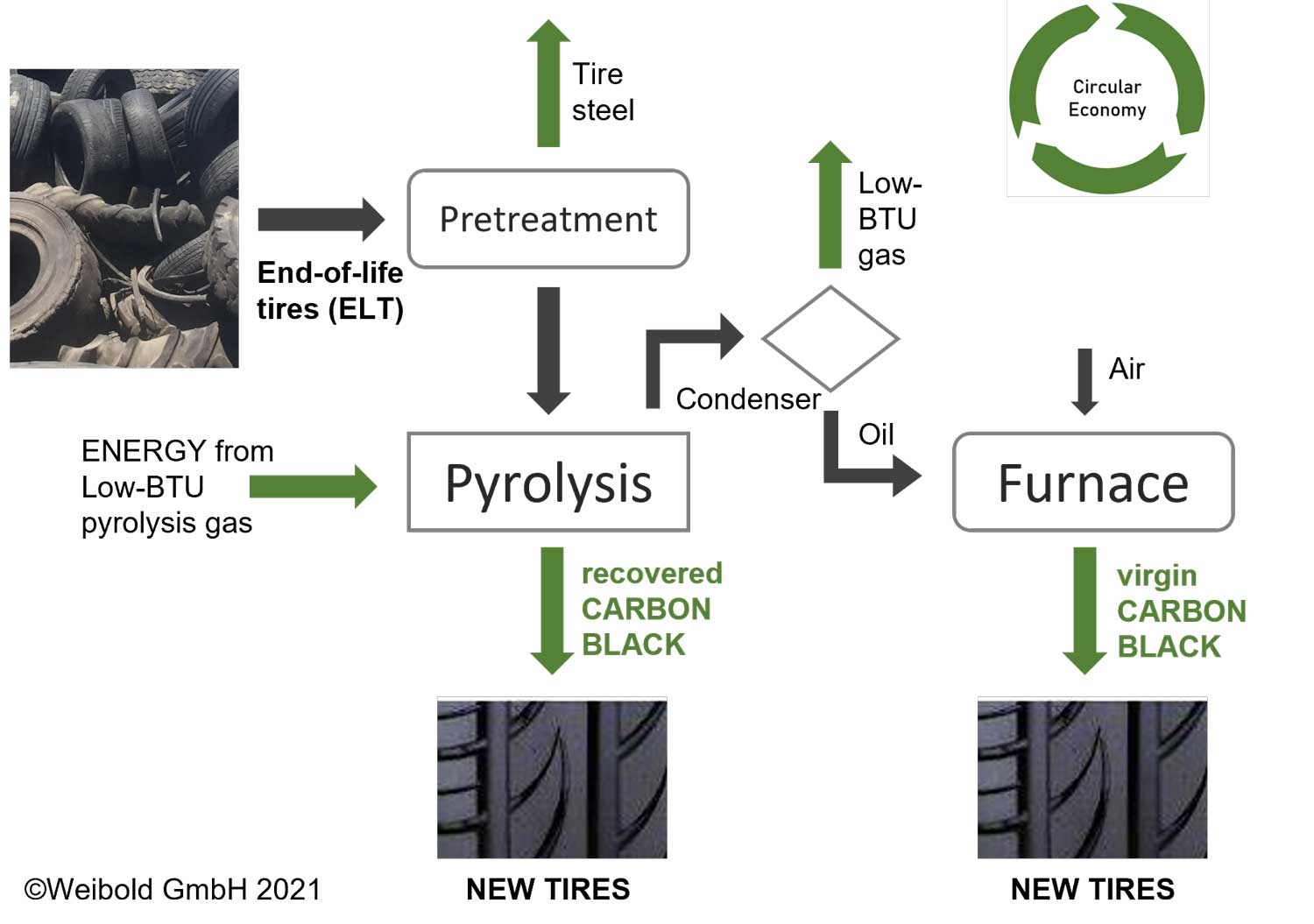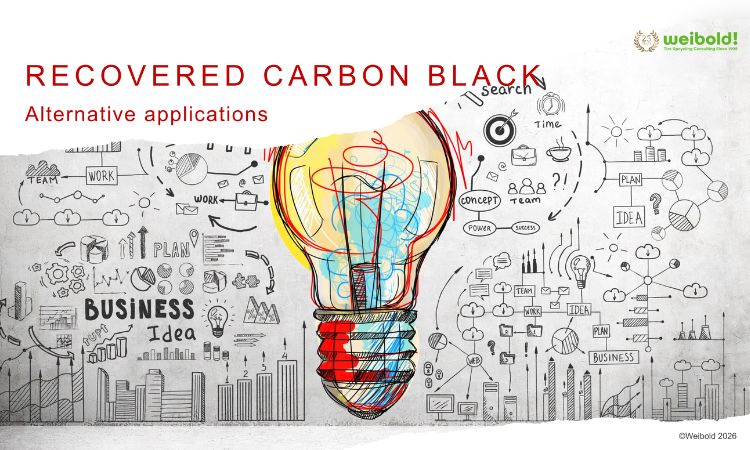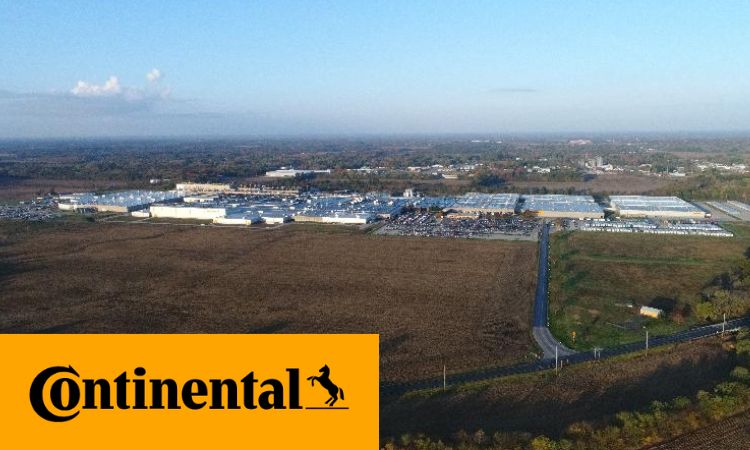Weibold Academy: Sustainable Carbon Black produced from end-of-life tire pyrolysis oil
Weibold Academy article series discusses periodically the practical developments and scientific research findings in the end-of-life tire (ELT) recycling and pyrolysis industry.
This article is a review by Claus Lamer – the senior pyrolysis consultant at Weibold. One of the goals of this review is to give entrepreneurs in this industry, project initiators, investors and the public, a better insight into a rapidly growing circular economy. At the same time, this article series should also be a stimulus for discussion.
Introduction
State-of-the-art pyrolysis processes are an efficient, viable and sustainable approach for the valorisation of end-of-life tires (ELT) into oil, gas and recovered Carbon Black (rCB). They are thus an important step towards the transition to a low carbon, more sustainable, resource efficient, circular economy in line with the EU Green Deal and the UN Sustainable Development Goals.
Carbon Black (CB) is an irreplaceable component in tires. The current feedstocks utilized in CB production are fossil fuel-based resources, hence susceptible to volatile oil prices in addition to the associated high CO2 emission. According to the ORION Sustainability Report 2020 and Notch Consulting, the global demand for Carbon Black in 2020 was estimated to be 11.9 million tons (and consumed over 30 million tons of fossil fuel), while the GHG emitted by the carbon black industry as a whole have been 23.8 million tons. Notch Consulting’s forecast for carbon black demand in 2029 is estimated at 18.7 million tons (following the increasing tire production). Using the same intensity rate, GHG emission associated with the Carbon Black industry would increase by 13.6 million tons to 37.4 million tons.
The EU-Taxonomy explicitly cites the industrial (virgin) Carbon Black production as making a substantial contribution to climate change. To contribute to the climate protection goal, emissions from the production of Carbon Black must therefore be reduced.
It is shown that a transition from current fossil-based feedstocks to alternative feedstocks derived via pyrolysis of end-of-life tires is a plausible long-term pathway to ensure a sustainable production of CB at reduced costs. An important step in the sense of a circular economy.
Revival of a decades-old concept
The first conceptual proposals for substituting fossil carbon black feedstocks (CBFS) with pyrolysis oil from end-of-life tires were published by WÓJTOWICZ and SERIO in 1996. Subsequently, the U.S. Environmental Protection Agency (co-) funded a series of tests by Advanced Fuel Research Inc., the results of which were published in 2004.
Despite the experimental limitations (low temperature and laminar flow), the data for Carbon Black produced from end-of-life tires derived pyrolysis oil (TDO) were promising and generally fall into the range of values characteristics of ASTM carbon blacks. [WÓJTOWICZ et al., 2004]
In 2020, under the coordination of the tire manufacturer MICHELIN, the EU-HORIZON2020-funded 16-million-euro project "BlackCycle" started to roll out a circular concept for the tire industry. The BlackCycle project aims at creating, developing, and optimising a full value chain, from ELT feedstock to high-tech secondary raw materials (SRMs), with no waste of resources in any part of the chain and a specific attention for the environmental impact. In particular, the Carbon Black, a material representing ~20% of tire composition, will be fully obtained from oils extracted from waste tires through the pyrolysis process. [EU CORDIS Fact Sheet]
Opportunities and challenges
Judging by the abundance of publications on tire pyrolysis in general and recovered Carbon Black in particular, the substitution of fossil based CBFS by TDOs seems to have been overlooked until the start of the BlackCycle project.
Thanks to OKOYE and colleagues from The University of Western Australia, a literature review is available on this topic since 2020, which gives a good overview of the great opportunities in terms of transition to circular economy and the (minor) challenges of it.

Sustainable Carbon Black produced from end-of-life tire pyrolysis oil. | Graphics by Claus Lamer, Weibold.
Besides being a valuable feedstock for various chemical components, TDO presents an attractive source of renewable energy. It has come a long way in having been considered as a potential substitute for crude oil-derived products, or for use in a blend with them. The raw waste tire-derived pyrolysis liquids are most economically and energetically attractive products. However, their fuel application is challenging because of several properties: their distillation characteristics, a wide boiling point range, flash point, cetane number, density, PAH content, sulphur, chlorine content, etc. and a distinct lack of clarity to what constitutes action toward TDO quality gate limits to be supplied to refineries for further processing. These challenges are circumvented if TDOs are used as raw material for CB and all problematic substances that would be released when used as fuel are destroyed by the high process temperatures (up to 1900 ° C) or bound in the manufactured product. Thus, upgrading raw tire-derived-oils (TDO) with chemical and physical techniques, although associated with a cost, is appropriate to further enhance the TDO properties.
TDO contains of over 100 identified compounds, dominated by aromatics, aliphatics, heteroatoms and polar fractions. [Kaminsky et al., 2009; Banar et al., 2012 cited in OKOYE et al., 2020].
The high aromatic content of TDO is an essential parameter in the selection as a good CB feedstock. Polycyclic aromatic hydrocarbons (PAHs) are a necessary precursor for CB formation (carbon nuclei formation) and a high aromatic content improves the CB production yields. [OKOYE et al., 2020]
According to WÓJTOWICZ and colleagues the sulphur content of TDO has no effect on the CB production yield, surface area, and particle size (although the sulphur content in any CB feedstock is always associated with emission and environmental protection requirements).
To produce CB with the furnace method, a high carbon to hydrogen ratio and high aromaticity of the feedstock is important. A good CB feedstock has a H/C ratio in the range of 7.10 to 13.30. Several pyrolysis studies have shown that TDO has an H/C ratio in the range from 7.30 to 12.90, like conventional CB feedstocks. TDO as a CBFS is additionally attractive because of its high aromatic hydrocarbon content. TDO shows a consistently higher aromaticity (up to 51 wt.%) than the “ideal CB feedstock” coal tar (~18 wt.%). [OKOYE et al., 2020].
Conclusion
The carbon C/H, sulphur and aromatic contents of pyrolysis oil derived from end-of-life tires (TDO) are comparable with the fossil-based fuel feedstocks utilized in commercial CB manufacturing. The performance of TDO in terms of feedstock to CB conversion yield and other industrial properties are not only similar to that produced with a fossil fuel feedstock but also are consistent with ASTM standards for CB even though it has been relatively overlooked. [OKOYE et al., 2020]
The utilisation of TDO in CB manufacturing can therefore offer a sustainable approach to provide a cleaner route to the production of cost-effective Carbon Black.
The BlackCycle project coordinated by a leading tire manufacturer (Michelin) in which authoritative entities such as ORION Engineered Carbon GmbH, PYRUM Innovations AG, CIENTIFICAS, ALIAPUR, SISENER INGENIEROS SL, and others also participated, will likely result in a comprehensive understanding of the combustion chemistry of this sustainable feedstock, which is essential in predicting the performance and control of CB formation. This can pave the way to the realization of practical application of TDO as a cleaner alternative feedstock for CB production on a commercial basis.
Literature
- Chiemeka Onyeka Okoye, Isabelle Jones, Mingming Zhu, Zhezi Zhang, Dongke Zhang, Manufacturing of carbon black from spent tyre pyrolysis oil – A literature review, Journal of Cleaner Production, Volume 279, 2021, 123336, ISSN 0959-6526 (document available here).
- Wójtowicz Marek, Bassilakis Rosemary, Serio Michael. (2004). CARBON BLACK DERIVED FROM WASTE TIRE PYROLYSIS OIL. Proceedings of the Carbon 2004 Conference, Brown University, Providence, RI.
- Wójtowicz Marek, Serio Michael. (1996). Pyrolysis of scrap tires: Can it be profitable? Chemtech October 1996 (document viewed on October 10, 2021).
Weibold is an international consulting company specializing exclusively in end-of-life tire recycling and pyrolysis. Since 1999, we have helped companies grow and build profitable businesses.









